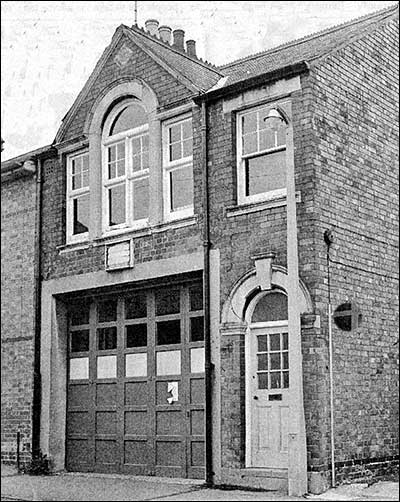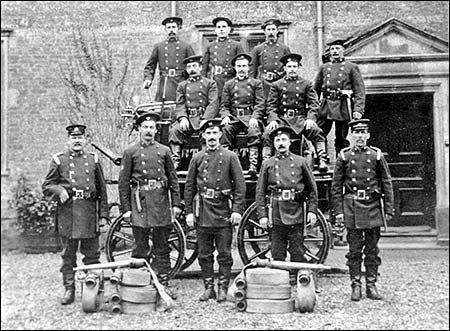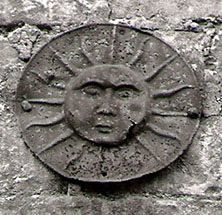|
In 1707, an Act of Parliament was passed which required every parish to provide its own fire engine, which in Burton Latimer, like most other towns and villages, would have been the responsibility of the churchwardens and kept in or near the church but, just as before the Act, for serious fires they would have relied on outside help.
The Constable’s Accounts for May and June 1693 seem to indicate a series of fires in Burton Latimer, which were attended by men from Isham, Kettering and Wellingborough.
May 15th: “To Wellingburrow men that watch all night: 4 quarts of ale 1s.
To Wellingburrow men ordered by Edw. Wood [Constable] ye second Fier 6 quarts of ale & bread & cheese: 2s.
Upon ye accompts of ye fier June 13
Ordered by Hue Bennitt [Constable] to 14 on ye watch at ye fier 1s
Ordered by Michel Lovell [Constable] to 7 men on ye watch at ye fiier 4 quarts 1s
In the early 18th century, insurance companies started to operate across the country and people could take out insurance against fire. As these Companies grew, some started their own fire brigades to help fight fires at properties insured with them. It is believed that the Sun Fire Insurance Company (est. 1710) was one of the companies that operated in this area, and that they may possibly have had a fire brigade of some description which would fight fires at the properties of people insured with Sun Fire Insurance. It is likely that any brigade operated by the insurance companies would have been based in the larger towns such as Kettering and Wellingborough, rather than in a small village such as Burton Latimer would have been at the time. It is known that the Sun fire office had an office at Finedon in the late 1880s and they themselves, as well as other fire insurance companies, were still advertising for business at that time.
|
|
A Sun Fire Insurance Co.
mark at 79 Church Street |
|
Any properties insured with an insurance company would have had a plaque fitted to the building to show which insurance company they were with. In the event of a fire the insurance fire brigades would turn out but they would only put out the fire if the property was insured by their company. It was not uncommon for more than one insurance brigade to attend a fire. On arrival, whichever brigade was not required were more likely to hinder the other crew rather than attempt to help to put out the fire. In later years this practice was stopped and the insurance brigades worked together when fighting fires. With reference to the plaques used by the insurance companies, there are believed to be at least two properties in Burton Latimer, which still have these plaques on their walls; these are Home Farm, Kettering Road and a house in Church Street. |
|
Very little information is available about fire-fighting in Burton Latimer before the beginning of the 1900s. It is possible that the insurance brigades could still have been operating up to the late 1800s as is known to have been the case in other areas, but the Kettering brigade was called out for serious fires. Soon after it was formed in 1895, the new Burton Latimer Parish Council took over responsibility for fire-fighting and created the first council fire brigade to attend any fires in the area. It is known that Burton Latimer fire brigade has always been a retained brigade rather than full time and that to the Second World War, the Parish Council’s successor, the Urban District Council, ran the brigade. From the turn of the century onwards there are still no proper records to be found, the only clues being in newspaper reports from the period and any photographs that are available, some of which are on display at Burton Latimer fire station (to read a report of an early 20th Century inspection and sports, click here). The only definite records found so far are the records of calls attended by Burton Latimer fire brigade since the end of 1968, although the first two years of these only list the dates and times of calls. From 1971 onwards the records of calls are mostly all complete with the details of the incidents attended.
A Local Government Enquiry was held in February 1900 to look into a request by Burton Latimer Parish Council for permission to borrow money to build a new council chamber and fire station. An article in the Northampton District Reporter of 17th February 1900 reports that:
"……… About two years ago the Council purchased a manual fire engine, which was at present located in an old barn belonging to the Coffee House Company (High Street). The present building was very unsuitable, for the rain penetrated the roof and affected the condition of the engine and appliances. The Council also had notice to quit the premises, and they had now been taken down. For the present, Mr. Gross had kindly found room for the fire engine in his farm (Home Farm, Kettering Road) but they were altogether unsuitable as a temporary establishment. ……………."
It is known that the council signed the cheque for the new station in February 1901 and that they held their first council meeting in the new council chambers above the fire station on 17th July 1901. When this station was built the cost of the land was £50 and the cost of the station itself was £383, with the building work being done by a Mr J. Goodwin of Kettering. The building was designed by Mr. Joseph Boardman, headmaster at the Church School and a Parish Councillor. As a point of interest, the council decided in May 1901 to insure the building against fire, this was done through the Royal Assurance Company. The building was insured for £450 and the furnishings for £50.
 |
|
The fire station after closure in 1973
|
|
The Duke Street station was a two-storey building, the ground floor was used as the fire station and the first floor was used as the council chambers for Burton Latimer Parish Council. This situation continued until 1942, when the council, which had become an Urban District Council in 1923, moved its chambers to their present location at the "Poplars" in the High Street. This then allowed the fire brigade to use the first floor of the building as well.
In May 1905, during the captaincy of William H. Henson, the brigade resigned en bloc and handed in their uniforms following a dispute with the Parish Council over the practice of taking their
Wellington
boots home with them and not leaving them in the station. Councillors had been informed that some of the firemen were wearing their boots whilst gardening and objected. The firemen stated that (a) the station was too damp to dry the boots properly; (b) the remainder of their uniform was kept at home and (c) the boots had been paid for by public subscription and not out of parish funds so were not part of the uniform supplied by the Council. During the next few months a new set of rules were drawn up and agreed upon in October, after which things got back to normal. (To read these rules click here.)
The station was not very large by today's standards: the appliance bay (or engine house as it was then called) only measured 30 feet by 14 feet. Off of the engine house was the duty room for the firemen. At the rear of the engine room was a small enclosed yard; this contained a small outside toilet as well as a pole for hanging hose to dry. From 1911, when they were introduced, there was also a post for mounting the maroon rockets when they were to be launched to call the firemen out. In earlier centuries it was believed to have been common in most areas to use the church bells to summon the firemen to a fire.
With regard to the horses that were used to pull the steam pumping appliance, they were kept in a field, possibly in Finedon Road, and according to one ex-fireman it was not uncommon for the horse to make its way to the bottom of the field upon hearing the rocket go up to call out the fire brigade. The horse would then run around the field in order to avoid being caught by the firemen. This apparently led on more than one occasion to the firemen pulling the appliance by hand to incidents.
After the council moved out in 1942, the upstairs of the station was used as a watch room / lecture room. Again this room was not very big, only measuring 25 feet by 18 feet. Off of this room was a store room. Before the council moved out this store room was used to store the village lamps through the summer months when they were not needed. This would have been before the introduction of the electric street lighting we have today. The watch room was very basic with just a telephone and writing equipment. In the event of a fire call, the first person to arrive at the station would go upstairs to phone the fire control to get the incident address. As the first man went upstairs, he would lower a wooden arm across the stairs behind himself, this told the rest of the crew that somebody was already up there, and also ensured that person a place on the appliance when they turned out.
During the Second World War, Burton Latimer fire brigade was made whole time for a short period. During this time, the crew had to sleep alongside the appliance in the appliance bay. During this same period the fire brigade also had control of the ambulance rooms in Alexandra Street
, where they kept a car and two trailer pumps in case they were needed for fire-fighting use in the area. (Click here for article - 1958 - about voluntary firemen from the Coles Group). For much of the latter period of the Fire Station's location at No 4 Duke Street, the appliance was a 2-door Bedford. The turn out system was via the old war siren in the council yard. This was live between 0700hrs till 2330hrs and firemen also had a bell installed in their homes, so to catch the appliance after 2230hrs they had to be at home.
As fire appliances got larger over the years,
Duke Street
station was deemed to be too small and a new station was built in
Pigotts Lane
. This station opened in November 1974, at which time
Duke Street
station was closed.
Duke Street
station was later sold and converted into a butcher’s shop. The new station was complete with its own drill yard and tower:
Duke Street
station had no yard, the tower being in the council yard on the High Street. The crews also used the Weetabix site to train, because of the different buildings and water sources, and the excellent conditions for practice lifting and carry-downs. The new station was complete with watch room, separate lecture room, kitchen, male and female toilets, shower, and drying cupboard for wet fire kit, as well as a large appliance bay built in line with
Pigotts Lane
. This allows the appliance a straight run down to the High Street. The only problem with the station access is that a lot of car and lorry drivers tend to use the Yard as a turn-round area. This has caused problems when the crew are turning out to the station and find a car or lorry turning round in their way. With the move to the new station also came the change from the old bell system to Pocket Alerters, this meant that firemen could be anywhere within 1 mile of the station and could respond. In the evening when they went to bed the Alerter was placed in a charger by the bedside. This would then alert them during the night so they could turn out and man the appliance, (and also avoided waking the whole household).
During 2005, the station was upgraded to meet modern day regulations with regards to access to council buildings for disabled persons. These alterations also included a fire kit storage room, to remove the kit from the appliance bay to prevent contamination by diesel fumes from the appliance.
The station at present is manned by fourteen personnel and is usually able to turn out with at least a crew of four on each daytime call, with night time calls usually being manned by a crew of six.
|


